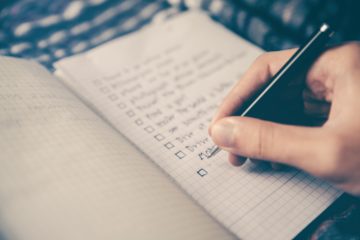Research interviews are a more structured, repeatable and directed version of the conversations you are already having with customers.
This section covers how you will get the most out of your time with respondents, and tips for how to effectively manage interviews to get high quality feedback.
PREPARATION
You have spent a lot of effort putting together your interview guide, recruiting participants and scheduling interviews. Allow yourself time to prepare so you don’t stumble in the first interview.
Know your interview guide and be comfortable with the questions in it. Read them out loud, and time yourself for how long it takes. If it takes longer than 20% of your interview time to even read the questions, the guide is too long.
Ideally, do a mock interview with a colleague, preferably someone who hasn’t read the guide beforehand. Ask them to provide feedback on clarity of the question language and on your pace and comfort with the guide.
STARTING THE INTERVIEW
As you start the interview, there are some details you want to cover with every participant:
- Introduce yourself – tell them your name, what team you’re on, and reinforce that you’re a neutral party with no stake in the specifics of the feedback, so they can be fully honest.
- Get verbal approval to record – your legal team will like you to have the respondent on tape that they consent to the session being recorded. I find this messy, as you have to ask permission to record, start the recording, and then ask again for their permission to be recorded. A good tradeoff is ‘ask permission to record → start recording → state on tape that you’re recording’.
- Let respondents know that they are free to skip sensitive questions – make it clear you’re not looking to ask about anything sensitive. If there’s an NDA in place, remind them of that fact.
INTERVIEWING BEST PRACTICES
- Display active listening – it’s challenging to strike up a rapport with people over Zoom, so use your body language to show that you are interested in their feedback. This can make a huge difference to the respondent’s enthusiasm.
- Look into the camera, not at their video.
- Use nods, head shakes, frowns and other facial expressions to visualize when you understand or need clarification. Try to direct them without verbal cues, as overlapping speech plays havoc with transcription software.
- Don’t divert your attention from the respondent without sharing why you’re doing so.
- Diverge from the guide when appropriate – the interview guide is a map, but you should follow the most useful path through the interview. Cut question and add others if you think it will offer richer insights, but when you ask about something that’s in the guide, use the language as written.
- Make judicious use of follow-up questions – maybe a quarter of your interview time should be spent on follow-up questions, digging deeper into interesting findings or segueing into new topics. Make sure your interview guide has space for these additions, but be careful to only pull on threads that matter, not on every topic that catches your interest.
- Talk less – you talk too much in interviews. We all do. Cut the small talk, interruptions, validations of what the respondent said, and other ‘conversation’-style comments..
- Don’t spend time on small talk – in consumer interviews you often spend time putting participants at ease. You can cut that in B2B interviews, where you rarely touch on personal topics. Save sensitive questions to the end of the interview, but jump directly into you interview questions.
- There’s no need to justify switching topics – in a regular conversation, it’s weird to switch topics without warning. In an interview, you’re wasting valuable time if you’re offering a preamble every time you move to a new topic.
- Avoid recapping a response in your own words – do it if you feel they’ve rambled on and you’re not sure what the takeaway should be, but it eats up valuable interview time that you could use better for other purposes.
- Pauses are a very useful tool – leave time after a respondent finishes their response. They often will fill the empty space with more details.
- Answer questions with questions – customers will want to ask you questions about roadmap, bugs, functionality, etc. Lobby the question back to them – “what would you want us to do?“, “how valuable is that feature to you?” – or promise to follow up in an email after the call.
TAKING NOTES
There are only two correct ways of managing note taking in interviews:
- A separate note taker assists you with taking note.
- You don’t take notes during the interview.
You will not be able to concurrently conduct an interview, be creative on the fly – thinking about interesting follow-up questions and implications of respondents answers – while you take in-depth notes. People who take notes do bad interviews.
That’s not to say you shouldn’t have a notepad ready to write down observations and ideas for follow-up questions as you hear them, but you need your full focus on the job at hand.
MANAGING INTERNAL PARTICIPANTS
Encourage internal stakeholders to attend interviews. The value of hearing from your customers live cannot be overstated.
In order to avoid chaos, have one lead interviewer who does most of the talking, and never have more than 1-2 secondary interviewers who can chime in. If you have more internal participants, set up a Slack channel where they can share questions they’d like to ask with the lead interviewer, who will ask the questions on their behalf.
The participants should read the research brief and interview guide ahead of time, to understand the context of the interview.
MANAGING CHALLENGING PARTICIPANTS
I rarely come across research participants that are deliberately difficult, but there are two common challenges even with participants who want to be helpful.
- Rambling respondents – people who give a five-minute answer to every question. Sometimes they stay on topic and their ramblings are useful, but often you want to move on.
- How to manage:
- Be direct when steering the conversation, and interrupt without hesitation. They likely know they can be long winded, so they won’t be surprised by interruptions.
- Ask narrow questions, and specify exactly what you want to know.
- Use body language to signal when you want to cut in.
- Accept that you will be able to cover less ground, and prioritize your most important questions.
- How to manage:
- Low-communication respondents – people who only answer the bare basics to your questions. Where from most respondents you get a paragraph, they give you a sentence.
- How to manage:
- Ask them to elaborate on their answer. And then ask again. Keep doing that.
- Ask follow-up questions that are close to the original question in different formats.
- Be extra expressive in your body language to reinforce that you care about their response and want more.
- Pause after their responses, to encourage them to keep going.
- Take the opportunity to ask the secondary questions that were passed over because of time in other interviews.
- How to manage:
For both types, if they make good-faith attempts to help, be patient and accept that you’ll get less out of the interview than you’d hoped for. It’s only one in a series of interviews, so don’t fret it too much.
AFTER THE INTERVIEW
As soon as possible after each interview, you want to record everything
- Transcribe the recording using a tool like Otter.ai. Clean up the automated transcription a bit, but don’t worry about perfection.
- Upload video and transcript to a folder shared with stakeholders.
- Revise the interview guide. Update question language, add new questions that worked well, and remove questions that don’t work.
- Pay incentives. A guide on how to incentivize participation, and logistics for how to manage it is here.
- Write up thoughts on what’s noteworthy, surprising, or new ideas from the interview. Five minutes of noting down your reaction makes a big difference in remembering the details of an interview.
NEXT POSTS
The guide continues in the following posts:

